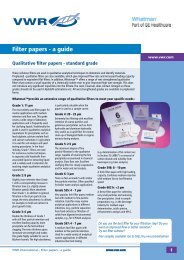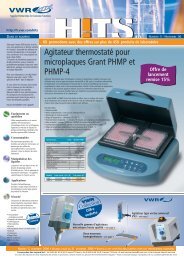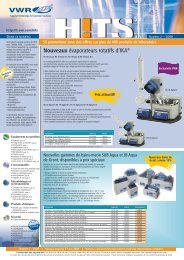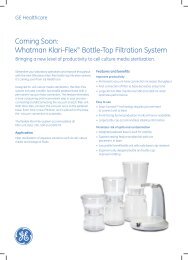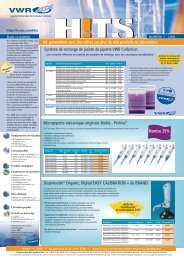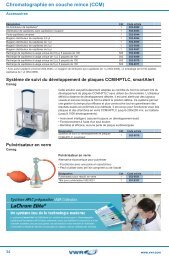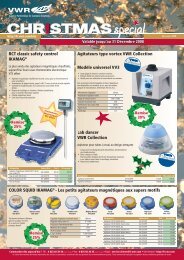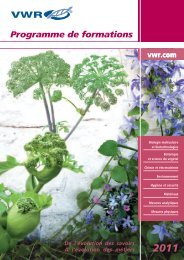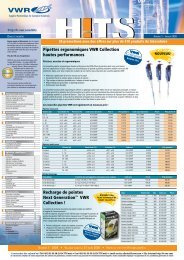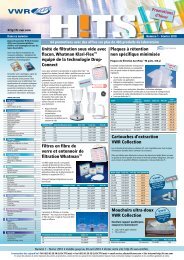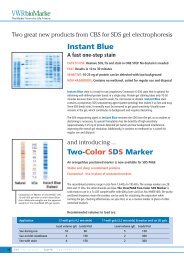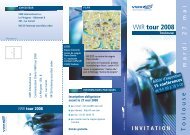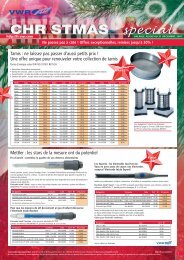FAST REPRODUCIBLE RELIABLE - Vwr-cmd.com
FAST REPRODUCIBLE RELIABLE - Vwr-cmd.com
FAST REPRODUCIBLE RELIABLE - Vwr-cmd.com
You also want an ePaper? Increase the reach of your titles
YUMPU automatically turns print PDFs into web optimized ePapers that Google loves.
Determination of biomass in suspension cell cultureswith VoluPAC tubes<strong>FAST</strong><strong>REPRODUCIBLE</strong><strong>RELIABLE</strong>Figure 1. VoluPAC tube for biomassdetermination from cell culturesuspensions.VoluPAC tubes from Sartoriusoffer a convenient andeconomical alternative tobiomass assessment which is atleast 5 times more accurate andabout 10 times faster thanmanual cell counting.The employment of VoluPACtubes for this purpose is basedon the determination of thepacked cell volume (PCV) in acell culture suspension.The method provides datawhich can be correlated withparameters like cell count ormetabolic activity and allowsfor close observation of cellgrowth kinetics in very shorttime intervals.When working with cell cultures, thedetermination of cell numbers using microscopictechniques is part of the daily routine. The mostwidespread method for counting cells relies onthe hemacytometer. This method is highlysubjective, prone to imprecision, and also verytedious. Even with careful attention to detail,the overall error rate is typically more than15%. Moreover, it usually takes 5 – 15 min toperform a single cell count. Automated cellcounters offer a more precise and fasteralternative, whether they are based on digitalimage recognition, making use of differences inthe electrical properties of the cells, or requirespecific dyes and buffers. Nevertheless, thesetechniques suffer from other drawbacks; theyoften require additional dilution steps,problems occur with cells forming microclusters(likewise with the manual counting method),and they are regarded as sophisticated andcostly techniques requiring special training.The determination of biomass expressed asPCV is a proven method applied by medicallaboratories where the PCV is known ashematocrit. Usually, a small sample of blood iscentrifuged using a capillary device; blood cellsare pelleted within the capillary and thevolume of the packed blood cells is determined.Mammalian cells grown in vitro usually do notreach densities which are conducive to theapplication of standard hematocrit devices. Tobe able to use this fast and straight-forwardtechnique the tubes had to be adapted to therequirements of mammalian cell culture.The VoluPAC tube is similar in size to standardmicrocentrifuge tubes. It consists of a samplevolume reservoir with a capacity of 1000 µl anda capillary with a maximum volume of 5 µldirectly attached to the reservoir (Figure 1). Thecapillary is graduated in 0,5 µl steps. For PCVmeasurements, aliquots of a well-mixedsuspension culture are transferred into VoluPACtubes. The tubes are then centrifuged in amicrocentrifuge equipped with a swingingbucket rotor for 1 min at 2,500 g (5,000 rpm).The height of the cell pellet is visuallydetermined by taking a reading from thecapillary graduation. The packed cell volume iscalculated from the following formula: PCV (%)= (volume of cell pellet/volume of sample) x100One of the key features of VoluPAC is theoutstanding precision of biomassdetermination, high-lighted by the followingexperiment. Ten individual samples from thesame CHO DG44 suspension culture weremeasured. The PCV determination was thenrepeated 1 hour later with the same culture.The statistical analysis of the results showedthat the standard deviation of the tenindependent PCV measurements was typicallyless than 1% of the average value. Thisindicated a high degree of reliability, superior12VWR International Issue 16 December 2006
Cell cultureFor more information on these products contact your local VWR sales office,send an e-mail to vwrbiomarke@eu.vwr.<strong>com</strong>or visit our website www.vwr.<strong>com</strong>> KEY FEATURES• Fast:1 min centrifugation<strong>com</strong>pared to 5-15 mincounting under themicroscope• Precise:Error rate < 5%, <strong>com</strong>paredto > 15% when countingmanually• Reliable:Less prone to statisticalerrors due to the highnumber of cells in the pellet• Reproducible:No user to user variations;no need for dilutions,manipulations, or calibrationsare necessary• Versatile:Works for all cell lines, noproblems with cells formingmicroclustersFigure 2. PCV determination inshort time intervals (30 min).Suspension cultures of CHODG44 and HEK 293 cells weredetermined during exponentialgrowth phase (n=3).to data which can be achieved by manualcounting. The increase of biomass within aperiod as short as 1 h was statistically relevantwith average PCV values of 0,484% and0,492% for the two time points (data notshown).To verify the high resolution of the PCV methodin respect to biomass increase in short timeintervals, samples from exponentially growingCHO DG44 and HEK 293 cells were taken every30 min over a period of 4 h. Results showed ameasurable increase in biomass from a startingPCV value of 1,17% for both cell lines up to1,49% and 1,36% for CHO DG44 and HEK 293cells, respectively. By fitting the data with anexponential curve, the specific growth rates (µ)were determined to be 8,6 x 10 -4 and 6,1 x 10 -4min -1 for CHO DG44 and HEK 293 cells,respectively (Figure 2). These valuescorresponded to doubling times ofapproximately 13 and 19 h, respectively.Neither manual cell counting nor automatedcounters allow for the measurement of cellgrowth in such short time intervals.To determine the correlation between cellnumber (counted manually) and PCV, sampleswere taken from CHO DG44 and NS0 culturessub-cultivated every 3-4 d. Data were assessedin duplicate twice every day for a culture periodof 30 d. Figure 3 shows average PCV valuesplotted against average cell density. It isFigure 3. Correlation between PCVand total cell density (assessed bymanual cell counting). CHO DG44 andNS0 myeloma cells were subcultivatedevery 3-4 d and samples were takentwice per day (n=2).obvious that the two cell lines have differentindividual cellular volumes; however, therelationship was approximately linear up to adensity of 4 x 10 6 cells ml -1 .This data clearly shows that the VoluPAC tubesfor biomass determination in suspension cellcultures provides results with very highprecision and reliability. Differences in growthkinetics and metabolic activity can be screenedwith a high time resolution. This is not feasiblewith other currently available techniques,namely the manual counting method with ahemacytometer. Thus, the VoluPAC tubesrepresent an invaluable tool for monitoringprocesses in biofermentation of different scaleswith various cell lines and diverse mediaformulations. Due to their ease of use, they canbe applied even by inexperienced users for theroutine assessment of biomass in every cellculture lab. In addition, the VoluPAC tubes havebeen demonstrated to be applicable to biomassassessment with bacterial and fungal culturesin suspension.ReferencesStettler, M. et al. New disposable tubes for rapid andprecise biomass assessment for suspension culturesof mammalian cells.Biotech. and Bioeng. (in the press) .VWR International Issue 16 December 2006 13



